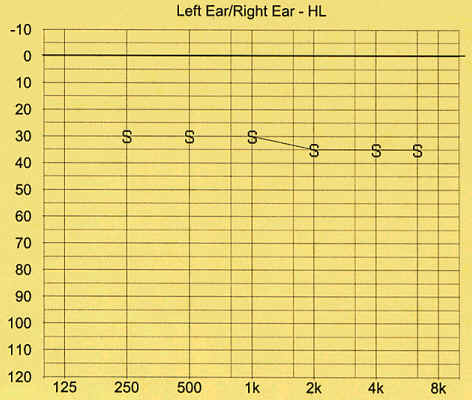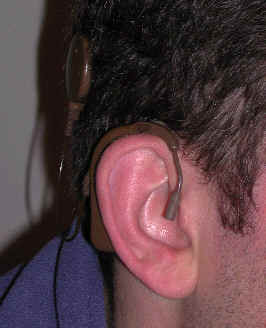
|
Paul Sommer's Cochlear Implant Journal
|
Entry #5: April 18, 2003 (five days after fourth mapping session)
On Monday, April 14th, I visit my audiologist, Jennifer Yeagle, again in Baltimore at Johns Hopkins' Listening Center for my fourth mapping session.
The session begins with another stint in the audiology booth where I'm asked to click on a button whenever I hear a sound. I notice that Jennifer emits louder low pitch sounds first and then gradually lowers the volume (from bottom up in audiogram) testing to seeing how low the volume can go at that frequency. Then once she does a low pitch sound that I'm unable to hear, she then proceeds to do the same process at higher frequencies (from left to right in audiogram). Overall, Jennifer and I are very pleased with the results of the test, which shows that I can now hear at 30db level with my cochlear implant. Before getting the cochlear implant, I was literally (although nothing is guaranteed in medical field!) guaranteed that I'd hear at a minimum of 30db (see audiogram in Entry #1 for more detail) across the chart.

My high frequency hearing (which is denoted at 35db on the right side) is a little lower, but that can be attributed to test margin of error (approximately 5db) and the notion that my brain is still learning how to hear higher pitch sounds. This audiogram is also a significant improvement from the last audiogram (see Entry #3), which was created one week after my CI activation. In the last month, my hearing with the CI has jumped from 45db to 30db.
However, Jennifer and I take a reality check as we agree that audiograms are just medical or clinical expressions of how much I can hear at various frequencies whereas it does not measure how much sound I can discriminate. Having said this, I still have a lot of work or rehab to do, especially learning to discriminate sound better. In fact, I'm not close to par (maybe 40% there) with where I was with the hearing aids in terms of discriminating sounds. My brain is still learning to adapt to the new way I hear sounds, just like one who just received a prosthetic leg would learn how to walk again.
I ask Jennifer if my audiogram results could improve. She says yes - possibly to 25 or even 20db. She even mentions that it could go up to 10db, but makes it very clear that I'm reaching my hearing level plateau very soon. Jennifer also reiterates that it does not matter whether it's 30, 20, or 10db; it's my ability to discriminate sound that matters most. If I go up to 10 or 20db, the sounds could sound very distorted, therefore making it difficult for me to discriminate sound.
Jennifer and I proceed to do the fourth mapping. We go through the same process as always. Overall, Jennifer boosts the power (volume) of my CI to be slightly louder than what I had in the third program from the previous mapping. I tell Jennifer that I'm picking up too much environmental sound, making it hard for me to hear people's voices. For example, as soon as Jennifer boosted the volume on my CI, I can hear the fan in her office again, making it difficult for me to hear Jennifer's voice. Hence, Jennifer promptly turns down the IDR (which controls the range of background sound) from 60 to 50. I also inform Jennifer that I'm having a bit of trouble discriminating the six Ling Sounds, especially MM, OO, EE, and AH (for more info about the Ling Sounds, see Entry #4). Jennifer then runs through these sounds and tinkers the power at the frequencies that best match the four Ling Sounds that I have difficulty with. After a little tinkering, I'm able to discriminate the Ling Sounds better, but Jennifer reminds me it's "not all in the shoes." It's "practice that makes perfect!" So Sarah continues to help me work on the Ling Sounds. Below are the results from last week just before my fourth mapping (Red = Incorrect, Blue = Correct):
| Distance | MM | AH | EE | OO | SH | SS |
| 3 feet | AH | AH | OO | OO | SH | SS |
| 6 feet | AH | OO | EE | MM | SH | SS |
| 9 feet | OO | AH | S | MM | SH | SS |
And here are the results from two nights ago (five days after the fourth mapping):
| Distance | MM | AH | EE | OO | SH | SS |
| 3 feet | MM | AH | EE | OO | SH | SS |
| 6 feet | EE | AH | MM | OO | SH | SS |
| 9 feet | MM | AH | EE | EE | SH | SS |
Now that my CI is well mapped, we are ready to differentiate the three programs on my CI. But before we continue, Jennifer asks if I'm ready for the T-Mic, which is an accessory that serves as a microphone better positioned to pick up sounds in front of you and is more compatible with the telephone. Jennifer and I agree that I'm not ready for phone usage, but I definitely would like to try to improve the directional placement of the microphone. Hence, we place the T-Mic onto the CI and map the three programs as follows:
Program 1: 50% from T-Mic and 50% from regular CI microphone (or 100% from regular CI microphone if I take off the T-Mic).
Program 2: 90% from T-Mic and 10% from regular CI microphone (or only 10% from regular CI microphone if I take off the T-Mic - yes, I would lose 90% of sound pickup).
Program 3: Same as Program 2, but approximately 15% louder (for if and when my brain is ready for more power).
In the last few days since the fourth mapping, I experiment with Program 1 and 2 in various situations, but am noticing too small a difference for me to conclude anything yet. But Program 2 is a little risky, especially if the T-Mic breaks. Hence, I need to order a back-up T-Mic.
The picture below on the left shows my cochlear implant with the regular CI microphone just between the clear earhook wrapping around the top of my ear and the brown electronics module just to the left behind the ear. The picture on the right displays the T-Mic. The T-Mic's microphone is just outside of the ear canal.


Note that you can't even see any sign of the nine-inch scar resulting from the CI surgery!
Now that I have the three programs all set, Jennifer and I conclude the fourth mapping session and agree to meet three months later in mid-July for the fifth mapping.
Meanwhile, Sarah continues to help me with home therapy. In addition to the Ling Sounds, we regularly use the picture charts and various lists of questions or sentences (as described in Entry #4). I continue to make significant progress as I am getting better and better at discriminating what Sarah says as long as I have visual cues. I also just got four tapes with accompanying books, including the Make Way for Ducklings by Robert McCloskey; Berenstain Bears and the Bad Dream by Stan and Jan Berenstain; The Cat in the Hat by Dr. Seuss; and One Fish, Two Fish, Red Fish, and Blue Fish also by Dr. Seuss. I read along the accompanying books as I listen to the tapes to build on my auditory skills, but I am having trouble keeping up, largely because of the speed and uncertainty if I'm in the right place after a while. It could have to do with the storyteller's voices. I'm told that if Robin Williams did any of the read-alongs, it'd be impossible to follow at first! But Sarah helps me out and tries to keep me on track until I get it right.
A few observations since the fourth mapping:
With the windows open at home, I'm pretty sure I could hear birds outside. If it isn't birds, it is definitely some other constant high pitch sound coming from outside.
The sounds I hear with the CI seem much crisper than those that I heard with my hearing aids. For example, helicopter noise sound very crisp with the CI whereas with the hearing aid, it was much more of a droning sound. Bear in mind that the hearing aid is like having a bullhorn in my ear! However, my CI continues to sound somewhat mechanical, but I'm noticing improvement on a weekly basis.
That's all folks, for now. Stay tuned for the next update with detail on my therapy progress in a few weeks.
Next (Entry #6: June 1, 2003 - 12 weeks after CI activation)
Back (Entry #4: April 11, 2003 - one month after CI activation)
| Entry #1 | Entry #2 | Entry #3 | Entry #4 | Entry #6 |